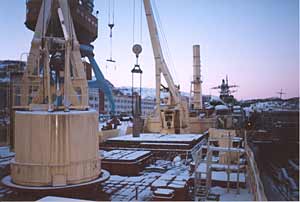
The system built to manage Russia’s nuclear legacy is crumbling, our new report shows
Our op-ed originally appeared in The Moscow Times. For more than three decades, Russia has been burdened with the remains of the Soviet ...
News

Publish date: December 14, 1999
Written by: Igor Kudrik
News
Murmansk Shipping Company’s (MSCo’s) nuclear fuel support vessel Imandra defuelled a general-purpose nuclear submarine at Nerpa shipyard at the Kola Peninsula – an operation called ‘experimental’ by Murmansk officials. MSCo operates nuclear powered icebreakers in Murmansk.
Imandra, which is used by MSCo to refuel nuclear powered icebreakers, made its first trip to Nerpa shipyard and defuelled two reactors of Victor-II class submarine (K-476) commissioned in 1975. The whole operation lasted from November 26 and until December 4. No incidents were reported during the operation. The fuel has been in submarine’s reactors for around 10 years. Imandra has a room for 1.500 fuel assemblies. The fuel is being currently transferred to another MSCo’s service vessel Lotta at Atomflot base in Murmansk. The fuel will be further loaded into TK-18 transport casks and shipped to the Mayak plant in Siberia for reprocessing. The spent fuel transport train is scheduled to arrive in early January 2000.
Experiment to become regular practice?The Co-operative Threat Reduction program, or CTR, is currently trying to work out a project regarding decommissioning of Russian general-purpose nuclear submarines. Until today, CTR has been paying for decommissioning of only ballistic missile submarines (SSBN), being in process of scrapping 31 of them. This approach caused a protest from the Russian side, which claimed that the relatively new laid up strategic submarines do not pose danger to environment to the same degree as the older general-purpose subs do. CTR was responsive to the critics to start working on the general-purpose submarines project, but it has not moved much ahead since the Russian Defence Ministry failed to date to provide adequate information to perform the project assessment.
CTR was established in 1991 by the Department of Defence to help reduce formerly Soviet weapons of mass destruction. Since 1991, Congress has provided $2.3 billion to support CTR’s efforts.
Murmansk County officials have stressed the importance of the general-purpose submarine project when the British General Consul visited Murmansk in mid November this year. The Great Britain has pledged earlier to spend three million British pounds on nuclear clean up works at the Kola Peninsula, but seems to be unsure in selecting concrete projects. The County officials insisted on spending money to scrap general-purpose submarines.
Around 80 general-purpose submarines in the Russian Navy have already been pulled out of service or are earmarked for removal. The major part of them is laid up at the bases of the Northern Fleet at the Kola Peninsula.

Our op-ed originally appeared in The Moscow Times. For more than three decades, Russia has been burdened with the remains of the Soviet ...

The United Nation’s COP30 global climate negotiations in Belém, Brazil ended this weekend with a watered-down resolution that failed to halt deforest...

For more than a week now — beginning September 23 — the Zaporizhzhia Nuclear Power Plant (ZNPP) has remained disconnected from Ukraine’s national pow...

Bellona has taken part in preparing the The World Nuclear Industry Status Report 2025 and will participate in the report’s global launch in Rome on September 22nd.